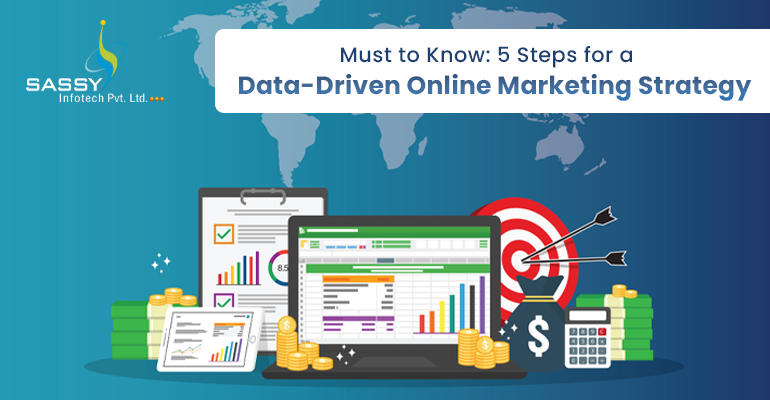It is important to have robust online marketing in this exponentially growing digital space. It is wise to implement a data-driven approach for the next marketing decision. To execute efficient and effective campaigns, ensure the data is backed by analytics and insights. Here are five steps to create a data-driven online marketing strategy that leverages SEO and content marketing, pay per click (PPC) advertising, email marketing, social media marketing, and website design. This guide is particularly relevant for businesses looking to excel in online marketing in India.
5 Key Steps to Success Online Marketing
Step 1: Know Your Audience
Start by gathering data related to the target demographic. Tools such as Google Analytics, social media insights, and other market research surveys can help to collect the information. The audience’s age, gender, location, interests, and online behavior can be useful.
SEO and Content Marketing: Utilize the data to create targeted content that aligns with the audience. For instance, if the target audience is primarily based in India, tailor the SEO strategies to include region-specific keywords and phrases.
Content marketing should focus on addressing the needs and interests of your audience, offering value through blogs, articles, and videos that answer their questions and solve their problems.
Step 2: Optimize the Website Design
Converting a visitors into customers can easily be done with the help of well-designed website. The website should not only be visually appealing but also user-friendly and optimized for search engines.
Website Design: Ensure the website is mobile-responsive, as a significant portion of users in India access the internet via mobile devices. Fast loading times and easy navigation are essential to keep visitors engaged. Incorporate clear calls-to-action (CTAs) and make it easy for users to find the information they need.
SEO and Content Marketing: On-page SEO elements like meta tags, headers, and alt texts to be optimized for relevant keywords. High-quality content should be regularly updated to keep the audience engaged and improve the website’s search engine ranking.
Step 3: Leverage Pay Per Click (PPC) Advertising
PPC advertising is an effective way to drive targeted traffic to the website. With PPC, one can bid on keywords that are relevant to the business and display ads to users who are actively searching for those terms.
PPC Advertising: Platforms like Google Ads and Bing Ads allow businesses to create favorably targeted campaigns based on location, demographics, and search intent. In India, where competition can be aggressive, a well-executed PPC campaign can give an edge by placing the business at the top of search results. Regularly analyze the PPC campaigns to track performance and adjust the bids and keywords accordingly.
Step 4: Implement a Comprehensive Email Marketing Strategy
A data-driven email marketing strategy involves segmenting the email list and sending personalized, relevant content to each segment as per audience behavior.
Email Marketing: Group the email lists based on the analysis of users data upon considering various factors. The factors can be their engagement levels, history, purchase history, and much more. Craft compelling email campaigns that provide value, whether it’s through informative newsletters, special offers, or personalized recommendations. Monitor the email metrics such as open rates, click-through rates, and conversion rates to refine the strategy continuously.
Step 5: Harness the Power of Social Media Marketing
Social media platforms offer immense potential for engaging with the audience and creating brand awareness. Each platform has its unique strengths and user base, so it’s important to choose the right ones as per business needs.
SEO and Content Marketing: Social media can also play a crucial role in the SEO strategy. Sharing the content on social media can increase its visibility and drive traffic to the website, which can positively impact the search engine rankings.
Integrating Online Marketing Efforts
A data-driven online marketing strategy is not about isolated efforts but integrating various channels to create a cohesive plan. Wondering to bring them all together:
- Unified Goals and Metrics: Define clear objectives for each marketing channel and set KPIs to measure success. Ensure all channels are working towards the same overarching goals.
- Cross-Channel Analytics: Use tools like Google Analytics and social media analytics to track performance across all channels. Look for patterns and insights that can inform the strategy. For example, if certain keywords are performing well in PPC campaigns, consider incorporating them into your SEO strategy.
- Consistent Branding: Maintain a consistent brand voice and messaging across all channels. It helps build a strong brand identity and makes the marketing efforts more recognizable and effective.
- Continuous Improvement: Regularly review the data and adjust the strategies based on what’s working and what’s not.
Conclusion
Creating a data-driven online marketing strategy involves leveraging the power of SEO and content marketing, PPC advertising, email marketing, social media marketing, and website design. By understanding the audience, optimizing the website, running targeted PPC campaigns, implementing effective email marketing, and harnessing the power of social media.
For businesses focusing on online marketing, these steps can help navigate the competitive landscape and achieve sustained growth. Embrace the power of data, and let it guide the marketing efforts toward success.
